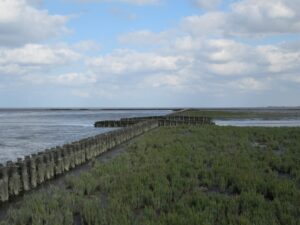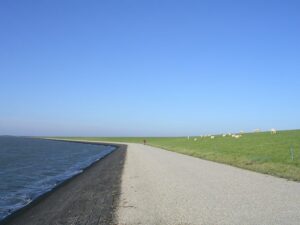Overview
Saltmarshes grow in the highest zone of beaches and mud flats. They can protect shorelines by stabilizing sediments and reducing currents and wave action. In this project Spartina anglica plants fixed in coconut mats are applied at three locations in the Eastern Scheldt, in order to investigate the potential of this method to re-establish pioneer saltmarsh. Under the right conditions (e.g. sufficient sediment input), the Spartina plants should grow out and form larger tussocks and subsequently meadows, thus adding to coastal protection, biodiversity and ecosystem functioning.
Location: Eastern Scheldt, The Netherlands
Date: 2012 – present
Involved parties: IMARES, NIOZ (former NIOO-CEME), Ecoshape.
Technology Readiness Level: 5 – technology validated in relevant environment
Environment: Muddy coasts, Rivers & Estuaries, Cities, Ports
Topics: Ecology, Spartina anglica, cord grass, saltmarshes, coastal protection, measures against erosion, biodiversity.

Salt marshes can protect coastal zones from currents and waves by stabilizing sediments and reducing wave action. The structures associated with the plants also induce deposition of sediment and organic material from the water column. This material is a source of food for fauna associated with these habitats. Salt marshes also provide economic benefits and contribute to a healthier ecosystem functioning.

Historically, coastal protection schemes have relied on hard infrastructure solutions such as seawalls, jetties and groins while ignoring or even destroying coastal marshes that could add to the protection. Moreover, hard structures often reflect part of the incoming wave energy, thus exposing the foreshore to extra wave action. This explains why seawalls often lead to a loss of beach.
